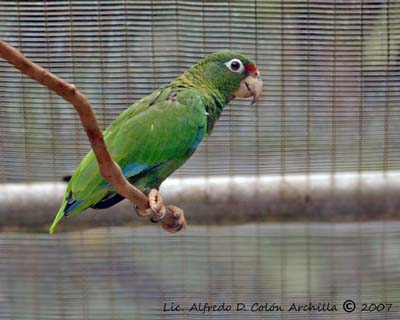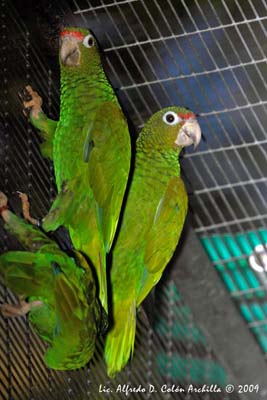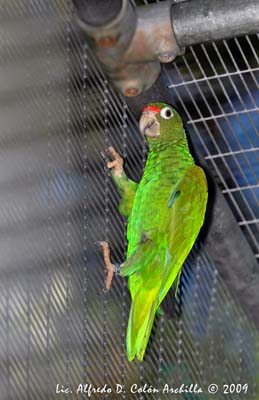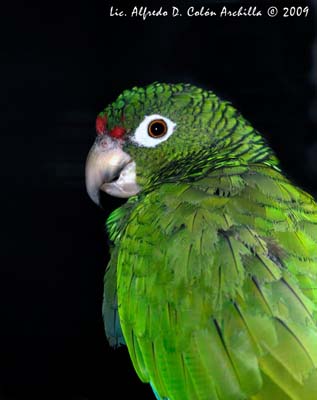
Puerto Rican Parrot
Amazona vittata
Psittaciforme Order – Psittacidae Family
BIOMETRICS:
Length: 29 cm
Weight: 250-320 g
DESCRIPTION:
Puerto Rican Parrot is endemic to Puerto Rico. This species belongs to the genus “Amazona” which gathers small to medium-sized parrots coming from the New World, particularly South America, Mexico and Caribbean.
Adult has green plumage overall, with slightly paler underparts. Belly is mostly greenish-yellow. On the upperwing, primary coverts and primaries are dark blue. Tail is green with some red at base.
On the underwing, primaries are tipped blackish.
On head, upper back, throat and upper breast, the green feathers are edged black, giving scaled effect.
On the head, lores and forehead are red. The hooked bill is pale horn-coloured. Eyes are brown, surrounded by broad, bare, white eye-ring. Legs and feet are pale brown.
PROTECTION / THREATS / STATUS:
Puerto Rican Parrot is CRITICALLY ENDANGERED, living in restricted range in Puerto Rico. This species suffered habitat loss with deforestation, human developments and trapping for illegal pet-trade.
Puerto Rican Parrot is preyed upon by birds of prey such as Red-tailed Hawk (Buteo jamaicensis) and some others, and also by the Pearly-eyed Thrasher (Margarops fuscatus).
Other predators such as honeybees, rats and Indian Mongooses involve competition for nesting cavities, and some of them eat the eggs.
Protection and recovery projects are in progress since 1968, involving protection of the habitat and control of predators.
This species is protected by laws against illegal pet-trade.
Fr: Amazone de Porto Rico
Puerto Rico: Cotorra de Puerto Rico
All: Puerto-Rico-Amazone
Esp: Amazona Portorriqueña
Ital: Amazzone di Portorico
Nd: Roodkopamazone
Russe: Пуэрториканский попугай
Photographs by Alfredo Colón
Puerto Rico Wildlife
Text by Nicole Bouglouan
Sources :
HANDBOOK OF THE BIRDS OF THE WORLD vol 4 by Josep del Hoyo-Andrew Elliott-Jordi Sargatal - Lynx Edicions - ISBN: 8487334229
PARROTS OF THE WORLD – An Identification Guide – by Joseph M. Forshaw – Princeton University Press – ISBN 0691092516
BirdLife International (BirdLife International)
Wikipedia (Wikipedia, The Free Encyclopedia)

Both sexes are similar.
Juvenile resembles adults, but it has pale yellow bill. Upper mandible shows pale grey base.
The other race, A.v. gracilipes, is smaller but now extinct.
VOICE: SOUNDS BY XENO-CANTO
Puerto Rican Parrot utters distinctive “kar…kar” while flying. Each note is given on descending scale. It also gives loud squawks when taking off, and some chuckling notes.
When perched, both mates perform duets.
HABITAT:
Puerto Rican Parrot frequents wet forests from moist mountainous forests down to coastal scrub forests and mangroves.
This species was formerly in most forested areas in mountains and lowlands. It is now confined between 200 and 600 metres of elevation.
RANGE:
Puerto Rican Parrot is endemic to Puerto Rico. This Critically Endangered species survives at mid-level in the wet forest of Luquillo National Forest Reserve.
BEHAVIOUR:
Puerto Rican Parrot feeds mainly on seeds, fruits, leaves, flowers and bark of numerous plants’ species such as trees, shrubs and vines. It usually avoids the small fruits.

These birds are usually seen in pairs or small groups, and frequent the same feeding areas during fairly long periods. They often feed high in canopy, well hidden among the foliage.
Puerto Rican Parrot is resident. During the breeding Season, the pair remains close to the nesting tree. They usually mate for life. The male searches for nest-sites, but female chooses it at the end. Then both mates clean the cavity. Male performs courtship feeding by regurgitation to female, before the egg-laying.
Puerto Rican Parrot is a gregarious species, but during the breeding season, the nest-site id defended, mainly by loud calls, against invading pairs.
FLIGHT:
Puerto Rican Parrot performs fast flight with rapid wing beats. It prefers to fly along valleys and ridges rather than over peaks.
This species is usually noisy in flight.

REPRODUCTION:
Breeding season occurs between January and July.
Puerto Rican Parrot is a cavity-nester, as all the Psittacidae.
It nests in natural cavities such as holes in tress, between 7 and 15 metres above the ground. The cavity is about 60 cm deep. Any material is added to the nest.
Female lays 2-4 eggs. Incubation lasts about 24 to 28 days, by female alone. She is fed by the male which remains in the vicinity of the nest.
Chicks are fed by both parents, and fledge 60 to 65 days after hatching. But they depend on adults until the next breeding season.
Young reach their sexual maturity at four years.
DIET:
Puerto Rican Parrot feeds mainly on seeds, leaves, flowers, fruits, bark and nectar found in the forest canopy.
